#4 - March 2025 - Lord of the Seal
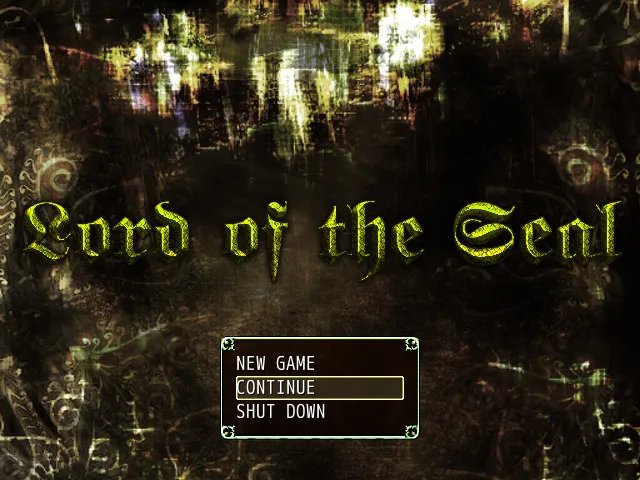
A couple of weeks ago, I was randomly reminded of a particular DRPG made in RPGMaker on Steam. It was 8 dollars, and had a barebones description that mostly mentioned the classes and not much else. If you were the type to check average player counts via SteamDB, it enjoyed a peak of ten players 8.5 years ago. On a whim, I bought it, and within the next few hours started quickly falling in love with Lord of the Seal.
I will be upfront--this game has a rough translation. Some terminology is a little goofy (being knocked out is called "battle impossible")1 and a lot of things have sort of slightly funky or off names in general. This is not a complaint, mind you--I'm well aware that an actual translation requires some permutation of time and money. The game's very understandable after you poke around a bit, and the game even includes a manual that explains some in-game terminology or what status effect icons or even passive effect icons on equipment mean, so it honestly ends up pretty easy to parse overall.
This is greatly to the game's benefit, because... well, to be honest, this game's for the sickos. I'm saying that with love in my heart. The main plot is extremely light and is mostly told in some very brief cutscenes that pop up between dungeon floors, and then there some equally thin side stories involving some of the other adventurers you meet in the main dungeon of the game. Almost all of your time will be spent on pure dungeon crawling, upgrading equipment, learning skills, occasionally farming certain materials, mapping floors, and tinkering with your party.
One interesting thing I did find is that as far as I can tell this appears to possibly be some kind of remastered version of an earlier title by the author, Nyankoro, called SEAL FOREST. SEAL FOREST came out in 2011 and was updated through 2013, featuring a lot of the same classes (down to the same portrait choices!) and mechanics that would return in Lord of the Seal. Lord of the Seal itself came out in 2015 and was updated through 2019, for comparison. On Nyankoro's blog here it seems they're continuing to work on new projects, but as far as I can see Lord of the Seal is their only title in English.
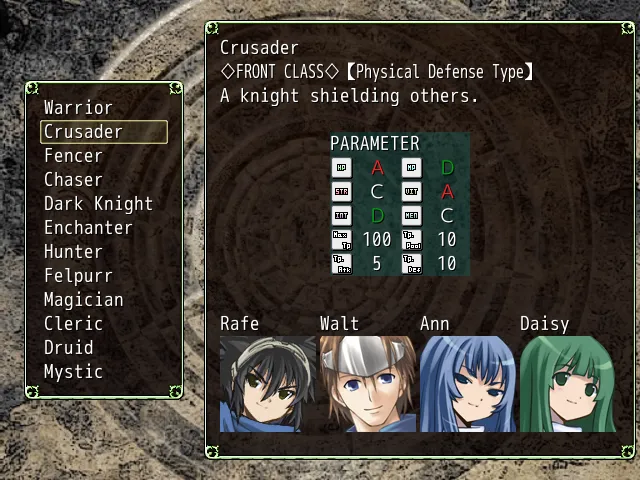
Lord of the Seal throws you in pretty quickly. You get to choose a portrait for your protagonist and their name, you get given a blazingly quick intro speaking of the city of Ragul, home to a massive forest labyrinth that adventurers have been diving into in pursuit of wealth and fame, and get directed to the city's Neless Hall to build your party. There's a total of 12 classes, and parties can fit 6 people. The protagonist must be included at all times. Each class has a total of 4 portraits with set names, but you can also rename them if you like.
Many are what you'd expect--Warriors are your bulky heavy hitters, Fencers are your rogue equivalent who explicitly get a huge damage bonus if they're not too weighed down by their gear, the unfortunately named Chaser is a class entirely based upon following up both on party member attacks with their own hits, or even attacking automatically when party members are damaged. Druids focus on status effects, and Mystics are a support class focused on buffing allies. You can swap party members in and out at any time, although there's no catch-up experience so it can be a bit of a pain.

One interesting thing about Lord of the Seal is that there's absolutely zero equipment restrictions. A warrior can use whatever weapon they want, your fencer can use fist weapons if you prefer, and the main character whose class is translated as "Unknown" (in SEAL FOREST, the katakana for it was Novice) is well suited to using whatever since they're a jack of all trades. This is pretty fun, because... there's a LOT of weapons.
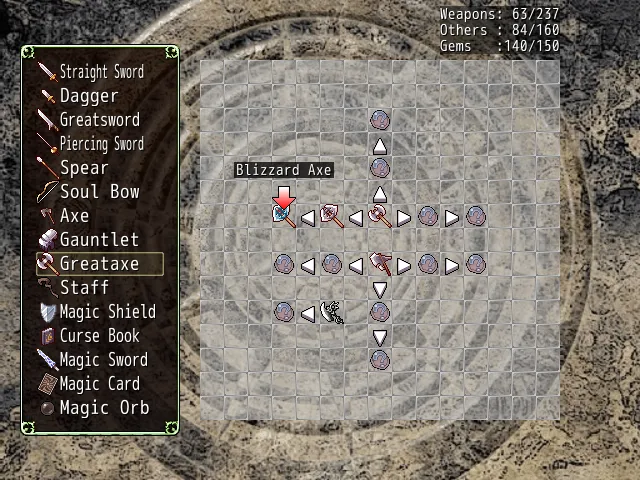
Everything on the above list is a weapon type, and each weapon has 2 early distinct sub-types (i.e. a dagger versus a silver knife) you can buy at the start. A dagger and a silver knife each have three different things they can be upgraded into, and then one final form after that. Every form has its own stats, and they come with their own active skills--many of which are extremely good--so there's a lot of potential decision making to be had there.
It's really only as complicated as you want to make it, all of that said--at the end of the day, think about what you want and there'll be an option that covers it. Enchanters are a melee-mage hybrid who by default wield sorcery blades that allow them to follow-up on their own attacks with extra magic damage hits, but maybe you'll have them use a normal caster staff instead, letting them sit safely in the back row where they can still contribute full damage at the cost of, frankly, magic swords being way cooler than staves. Maybe your Fencer will stick with lighter daggers or even fist weapons so they can get away with slightly heavier armor, or just to let them fit in extra accessories they didn't have the capacity to wear before.
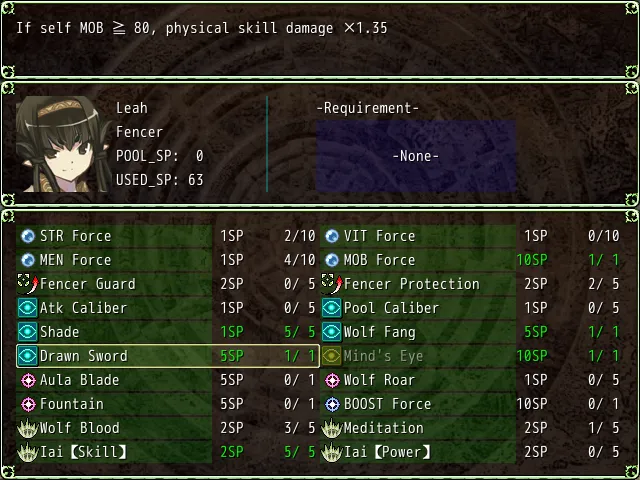
Of course, equipment isn't everything. Characters have skills and gain SP from leveling. Unlike Etrian Odyssey or some other dungeon crawlers, nothing really has pre-requisites besides character level. Every class has a capstone passive they can learn at level 25, and everything else is free game, although most active skills won't let you finish maxing them until level 20+. Skills oftentimes have extra incentive for maxing them out--active skills gain more uses per dungeon run once you fully level them on top of getting a little bit stronger every level, and generic stat boosting passives or damage/status effect resistance passives give an extra chunk of stats or resistances when maxed out.
This is not a game where you'll be able to max everything since there is a hard level cap, although there are items you can buy for a pretty affordable price later to reset your SP investments so you can adjust builds easily.
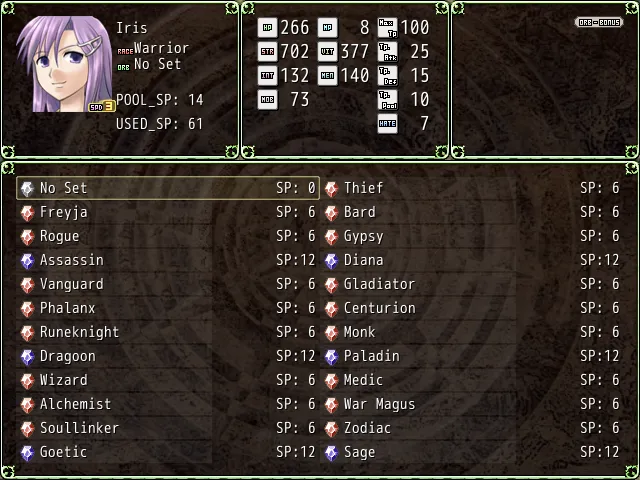
... And of course, there's sub-classes. Sort of. They're called "orbs" and really, all they do is modify your stats at the cost of some of your skill points. You can swap them or entirely remove them at any time in town, and they're quite helpful as some can provide aggro modifiers to make a character more/less likely to be targeted, or help shore up a character's offensive or defensive stats. You start the game missing quite a few orbs and will unlock them over time, with later unlocked ones usually being more expensive to equip but with better bonuses.
It's probably no secret at this point that I like lots of fiddly mechanics and knobs to twist and levers to pull when it comes to building a party. A great story with memorable characters in a DRPG is welcome--the 7th Dragon 2020 titles are among my favorite for a reason--but sometimes I just want to mess with a lot of numbers, and Lord of the Seal delivers so damn well. On top of this, there's also paying to boost equipment stats to further customize your party's loadout, there's gems to slot into gear, and every party member can wear up to 5 crests which confer either active or passive abilities and which can also be boosted like any other piece of gear. Some are buyable, many are quest rewards or drops from optional fights.
Casters especially love that last option, since on top of MP costs, all abilities in Lord of the Seal have limited uses per dungeon run, and there are a bunch of crests that give access to extra damaging or healing spells, and even some utility buffs that you otherwise may not have access to.
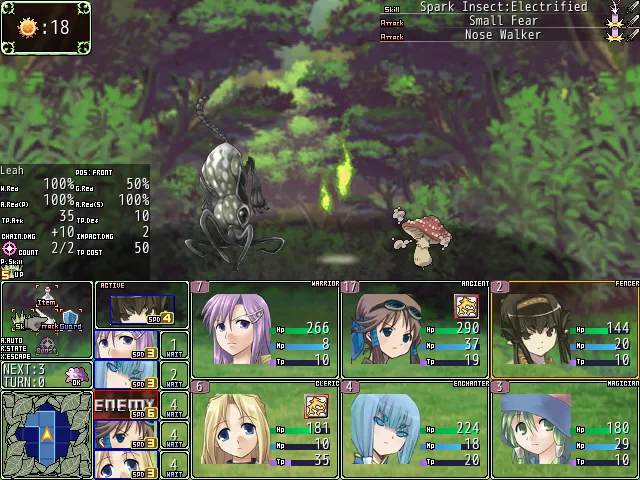
Combat is turn-based and has a timeline that displays wait timers by every character. In Lord of the Seal, the timeline is especially crucial since enemies can be briefly stunned by attacks that deal impact damage--every weapon and skill has an Impact value, though that value can be 0, and if an enemy's toughness pips are depleted via impact damage, they become briefly vulnerable. It doesn't delay their turn at all, and as soon as their turn comes back around they'll break free of the vulnerability. But during that vulnerability period, all attacks will benefit from a "chain modifier" that also exists on every weapon and skill--if a skill has a chain modifier of 50, it deals 150% damage on a vulnerable target. Thus, being mindful of the timeline can let you set up exceptionally devastating turns, especially since many skills that have cast timers tend to have ludicrous chain modifiers on top of already dealing high damage by default.
This leads to something that can be fun and a bit of a pain in the ass for bosses that move quickly--sure, you may want to keep chipping in damage, but one more hit might break their toughness, but the boss's turn is about to come around so it won't amount to anything. So maybe then you stall your damage and wait until everything lines up, or maybe you have your protagonist use some of their limited uses of Slow Order (to push the boss's turn back, thus extending the time they're vulnerable) or Quick Order (to instantly give someone a turn) to start messing with the timeline to set up a favorable burst damage turn. If you do it well, many boss fights become very brief sprints as long as you can weather their attack while you do your prep.
While this is a pretty strong mechanic on paper, the limitations of having to work around the very brief window to get that bonus chain damage while also making sure your damage dealers are both ready and able to actually use their high value skills in that window frequently makes it not quite as easy as "just break their toughness and unload on them".
As for the actual game outside of the specifics of party customization and the combat itself? It's a perfectly serviceable dungeon crawler. The main dungeon has 30 floors, with checkpoints every couple of floors. As the game goes on and both random encounters and the roaming FOEs become meaner, the two floor gap between checkpoints can sometimes feel excruciatingly long, and resource conservation comes heavily into play. MP is limited and MP items are both expensive early on and, due to items having a set weight, bringing them means you're bringing less of other items.
But having to go back to town early isn't so bad if you can't quite make it to the next checkpoint in the dungeon--Teleport Stones are cheap and light, so as long as you make it out of a fight returning home is easy. And Ragul's guild has quests both for fully mapping floors and also repeatable quests for turning in enemy drops, so you're always making some sort of progress. The guild even has its own guild point system where by completing quests or even just selling excess monster materials, you gain guild points that in turn raise your party's guild level, which comes with all sorts of unique rewards including more sub-jobs or rare gems. It's simple, but it's a good feedback loop.
While I think the general flow of combat and gameplay in general in Lord of the Seal is fun and I love the party customization, there's some definite downsides. Some are more of a pain than others.
I'll straight up say it--the game's environments are pretty bland. All 30 floors use the same forest tileset. A couple of side areas have a palette-shifted version of it, but that's about it. I frequently joke about Etrian Odyssey Nexus having too many damn forests, but I legally cannot make that joke anymore after Lord of the Seal.
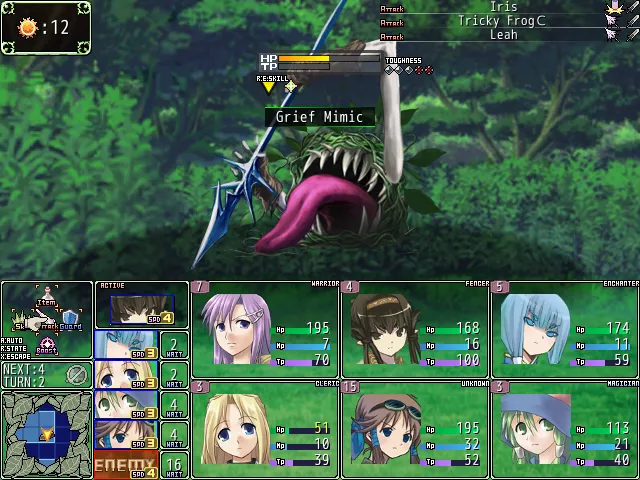
Secondly, mimics are a gigantic pain in the ass even though I love them. Every single chest in the dungeon, including chests you may get from a fight, can be a mimic. Dungeon chests reroll their chance of being a mimic on a save/load. When you're still early into a set of floors (the main dungeon is split into three chunks of ten floors each), a full health mimic is a devastating encounter. If you attack a chest and it's not a mimic, everything in the chest breaks. If you attack it and it is a mimic, you still fight it, but it's at half HP, at which point they're still dangerous but much more manageable.
The reward for them is always an arbitrary set of 3 gems--so, on the bright side, you're not losing out on unique equipment or useful consumables if you just avoid chests. Later on, a buyable item called an Ash Vial will clearly identify if the chest is a mimic or not. Although, again, consumables do have weight so you can't run around with dozens of Ash Vials.
Third, I do joke about mages dying all the time, but a particular passive effect that specific monsters can have that makes them focus fire low max HP targets is a serious drag in the endgame. If you get ambushed, one of your casters will likely die instantly since enemies routinely move very fast on the first turn, and getting ambushed means they'll likely get two turns on you. There are revival items and spells, so it's not the end of the world, but it does get a little silly feeling.
Fourth, the mobility stat... sort of sucks, but I also get it. All gear, even the crests that give new active skills, has weight (called "load" in-game). Load directly subtracts from your mobility 1:1. Everyone has 100 mobility baseline when naked. So, if a piece of equipment has a load of 5 and that's all you have, you're down to 95 mobility. Some gems when slotted into gear also add load but generally have better stats to compensate. What mobility actually does though is affect your speed in-battle based on certain thresholds. 91-100 mobility is its own threshold, 81-90 is its own, and so on. The fastest threshold is 5 speed, and it goes down by 1 per threshold, meaning that a character with 81-90 mobility has 4 speed compared to a 61-70 character's 2 speed. This translates into twice as many turns, roughly.
This is a long and tortured way of saying that heavy armor is extremely painful to wear, and that characters using heavy weapons will oftentimes want to use lighter armor, no/minimal crests, and don't wear any kind of equipment in their sub-slot to compensate. Being at 2 speed is just painful when so many bosses have anywhere from 5-7 speed. I understand the design intent, and I actually had a ton of fun doing Extreme Science to ensure my characters never went below 71 mobility at minimum, but I also sort of don't love how going below that threshold makes a character feel like a liability.
Finally, I will say there's a few things that are just plain obscure and make me wonder if I missed out on some things entirely in terms of the story or certain interactions.
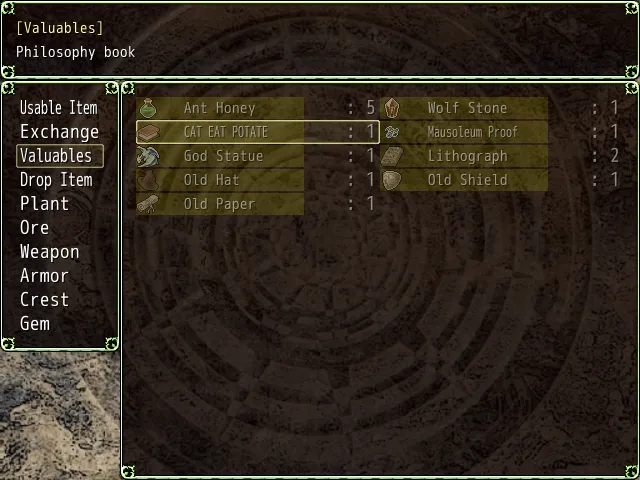
There's multiple key items I never did find out how to use, including the wonderfully named CAT EAT POTATE, and the ending I got definitely gave me the vibes there's something I may have missed, but I can't say for sure. This isn't really helped by stumbling upon a couple of secret areas near the end of the game that feature ominous floating cubes that do nothing but drain some HP from you. Do the cubes... actually do anything? Did I need to find them earlier, since I missed one back in the first region of the dungeon? Given how obscure the game is--I did some very brief searching around to see if there was anything comprehensive in English or Japanese, but came up empty-handed--I suspect these are questions I may not ever have an answer for. Though, that's not really a bad thing. A little mystery has its own appeal to it, after all.
But! All of that said, Lord of the Seal was wonderful for what I was really craving at the time, which was to sit down, create a party, and get overly attached to them as I continually got to mess around with tons of fiddly bits to optimize them however I saw fit. My save file's run-time was around 25 hours, likely a few more than that in reality since I did have a few game overs, and I can easily see myself replaying it in the future with a different set of classes. Maybe I'll even discover if there really is a different ending, or where that pesky alchemist's final slime is hiding...
That future party won't include a mage, though. I can't bear watching them get murdered in every single fight...
If you don't mind a dodgy translation and do enjoy dungeon crawlers that focus more on fun party customization and solid turn-based combat rather than a compelling narrative, and perhaps if you don't mind the dungeon tileset being identical for 30 floors, I can enthusiastically recommend Lord of the Seal. Please don't hurt me if your party wipes too often to the god damn mushrooms that spam AOE poison/sleep, though.
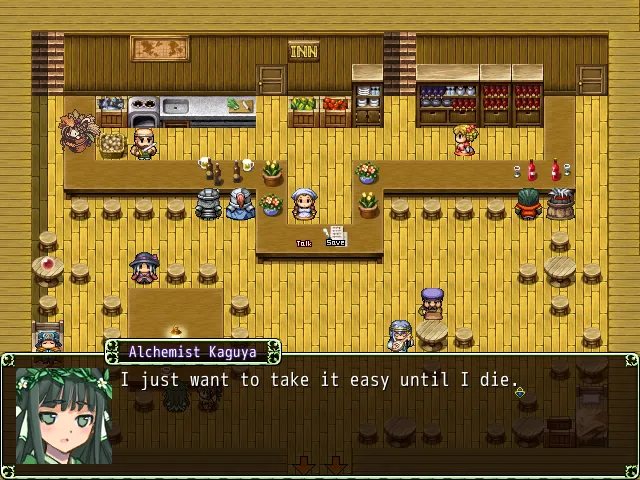
A dear friend of mine who is a translator commented that this is an extremely literal translation of 戦闘不能, "unable to keep fighting". The more you know!↩